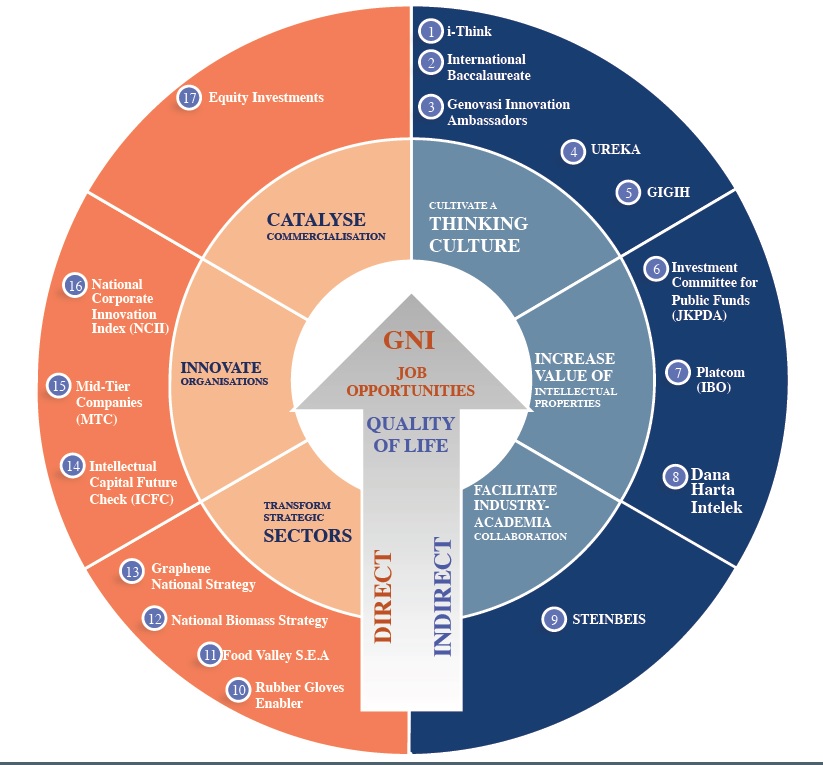AIM to be dissolved in 2020, programmes to live on
By Karamjit Singh June 16, 2014
- 18 initiatives divided into indirect, direct interventions
- Conference in August to highlight innovative practices

AS the government agency tasked with ensuring innovation becomes embedded in the national psyche, Agensi Inovasi Malaysia (AIM) will only know if it has been successful long after it has been dissolved.
Established in 2008 with a budget of US$21.7 million (RM70 million), AIM will cease to exist in 2020. It is hoped that by then, it would have done enough to plant the seeds of innovation in both the private and public sectors, while its various initiatives such as the recently launched PlatCOM and the Genovasi initiative launched in 2012 live on as sustainable programmes.
Until they find the magic pill that will make a nation and its companies innovative overnight, innovation will continue to be a long-term play and its successful application will continue to frustrate chief executive officers (CEOs), who are short term in nature; and even governments, most of which have a five-year term before seeking re-election.
It is because there is no one formula that works that AIM itself has taken a portfolio approach to give itself the best chance of success. And why, when you ask CEO Mark Rozario (pic above) what the agency has done so far, he asks, “How much time do you have?”
With 18 initiatives (see chart below) on the table, Rozario can talk about what AIM is doing until the cows come home.
And while the National Biomass Strategy, with its potential US$9.3 billion (RM30 billion) in incremental Gross National Income (GNI), gets most of the attention, there are other programmes that are noteworthy too, especially in planting the seeds of innovation.

Accelerating private sector innovation
When Digital News Asia (DNA) met him recently, Rozario was excited to talk about AIM’s latest initiative, the impending launch of the National Corporate Innovation Index (NCII). This, along with a few other initiatives, is targeted at the private sector.
This is a scorecard to measure the innovation levels in corporations. AIM sees this as a key initiative to help educate CEOs and corporations on the pressing need to change their way of doing business to stay competitive.
AIM hopes the introduction of the NCII will be the catalyst for companies to start thinking about the future through an innovation-led lens.
Aware that nothing works better than action, the introduction of the NCII has been wrapped around a two-day Innovating Malaysia Conference in August which AIM will use to highlight the practices of innovative companies in Malaysia, and how an innovation edge accelerates growth and profitability.
At the same time, AIM will also showcase 17 corporations it has partnered with to measure their innovation levels as role models for others to emulate.
“We will add some new companies in the second phase of this pilot and create a dashboard to allow companies to have a visual map of where their companies stand when it comes to being or not being innovative,” says Rozario.
AIM’s heavy focus on the private sector is partly driven by its mission to accelerate wealth creation through innovation. In light of this, it has also partnered with the Steinbeis Foundation in Germany to help create a platform in Malaysia that will bring academic brain power to bear on actual problems private companies have.
The Steinbeis model was established by a German academic to help small and medium enterprises (SMEs) bridge the knowledge and technology gap they face due to their inability to compete with larger companies for highly skilled technical staff.
The model has become a global success with over 90 countries adopting it. Rozario points out that the Stuttgart-based Steinbeis model is credited with transforming Germany’s Baden-Württemberg state from the poorest in Germany to becoming one of Europe’s highest income-per-capita states.
AIM is hoping for a similar impact here, with the Steinbeis Malaysia model aiming to provide an additional industry-focused platform to stimulate industry-academia collaboration from a market-driven perspective.
Researchers can spend up to 20% of their time on any collaboration. Steinbeis Malaysia will work out all the commercial arrangements and paperwork, leaving the researchers to fully focus on the problem they are trying to solve for the SMEs.
In return, Steinbeis Malaysia will get a small cut of the fee the SMEs pay to the academics. The first such project under this model has already started, according to AIM.
 Consolidating R&D&C funds
Consolidating R&D&C funds
Aware that there are similar models in Malaysia, AIM is careful in pointing out that this is “an additional option” for both researchers and private companies.
Its wariness is understandable as it has learned the hard way that an aggressive approach does not work, even when an agency is considered to have the support and ear of the Prime Minister.
The more conciliatory approach has worked well, it believes. A key example is how AIM has brought together all 15 agencies and nine ministries that have funds for research and development and commercialisation (R&D&C).
Under its Malay language acronym, JKPDA, which translates to Investment Committee for Public Funds, and chaired by the Minister of Science, Technology and Innovation, the committee acts to streamline the funding landscape and reduce duplication. All the parties also now share common KPIs (key performance indicators) so that outcomes can be fairly measured.
This happened in 2013, and aside from cutting down on duplication, it has also helped to reduce the funding gaps that exist. This past April, the exercise was repeated where each agency and ministry presented its plans to a committee for how it was going to allocate its budget for 2015. Any duplicated initiative was rejected.
Building on the momentum here, the next stage is to look at how the money has been allocated so there is accountability, says Rozario.
It gets more interesting later in the year when the entire process will be presented on a dashboard, with each ministry having access to this to view how its funding agencies are doing.
“And for the public, they too will be able to view this dashboard and for the first time, see what funds are available from the various ministries.
“This has never been done before and we expect this to be launched this September or October,” says Rozario.
“This was not easy to achieve and we had to convince them that AIM has no agenda here and is not trying to control them.
“Rather, it is about achieving a cohesive direction that benefits the nation and its entrepreneurs who need this funding,” he adds.
While questions can be asked about why such a seemingly obvious initiative has taken so long to be implemented, it will be hoped that this will be the trigger for more such transparency-based initiatives by AIM. All will be much welcomed.
Next Up: Introducing higher thinking skills into the public school system, and how far has AIM come after five years?
Related Stories:
Week in Review: University R&D not aligned to national interests
Innovation: More punk rock and counterculture needed
New AIM chief aims to deliver
Be innovative in inculcating innovation culture: MTDC chief
Malaysia has environment conducive to innovation: GE survey
For more technology news and the latest updates, follow us on Twitter, LinkedIn or Like us on Facebook.


